Cat body language is basically your cat’s non-verbal way of telling you how she’s feeling and what her intentions are by using various postures, movements, behaviors, and vocalizations.
These signs of your cat’s emotions and feelings can be expressed through any part of your cat’s body and their position, and it’s vital that you learn how to interpret those signs to develop a greater understanding of how your pet is feeling and what she’s likely to do next.
Your cat uses her body parts and their position to show when she feels content and relaxed, afraid and anxious, or aggressive. A cat that loves her owner will use various body language signs to show her affection and trust in you and tell you when she feels playful or curious. Finally, if your cat is in pain or is stressed, her body parts and their position can tell you that, too.
Body parts and their position include your cat’s tail and ears, her whiskers, eyes, body posture, position when sleeping, and how she holds her paws. Your cat also “speaks” her own language, using meows, purring, growls, and even howls to tell you how she’s feeling or what she’s doing.
This guide includes plenty of tips on interpreting and understanding what your cat is trying to tell you from her body language. So, if you’re a cat lover, you need to read this article!
What Are The Meanings Of A Cat’s Body Parts And Posture?
A cat’s body parts and posture have different meanings that you need to understand if you know exactly what your cat is trying to say to you.
Here’s a guide to what those physical signs mean.
Tail
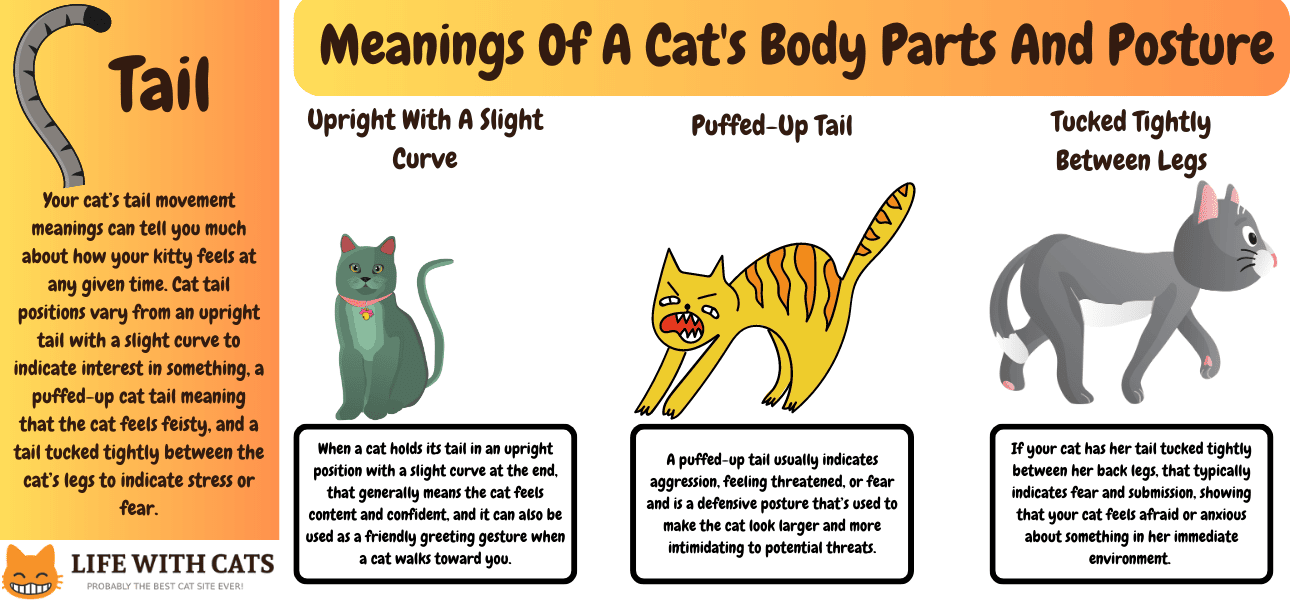
Your cat’s tail movement meanings can tell you much about how your kitty feels at any given time. Cat tail positions vary from an upright tail with a slight curve to indicate interest in something, a puffed-up cat tail meaning that the cat feels feisty, and a tail tucked tightly between the cat’s legs to indicate stress or fear.
Keep reading to learn more about cat tail movement meanings!
Upright With A Slight Curve
When a cat holds its tail in an upright position with a slight curve at the end, that generally means the cat feels content and confident, and it can also be used as a friendly greeting gesture when a cat walks toward you.
Both my cats always use that tail gesture, even when negotiating our narrow garden fence, which is very impressive!
Puffed-Up Tail
A puffed-up tail usually indicates aggression, feeling threatened, or fear and is a defensive posture that’s used to make the cat look larger and more intimidating to potential threats.
Tucked Tightly Between Legs
If your cat has her tail tucked tightly between her back legs, that typically indicates fear and submission, showing that your cat feels afraid or anxious about something in her immediate environment.
Ears
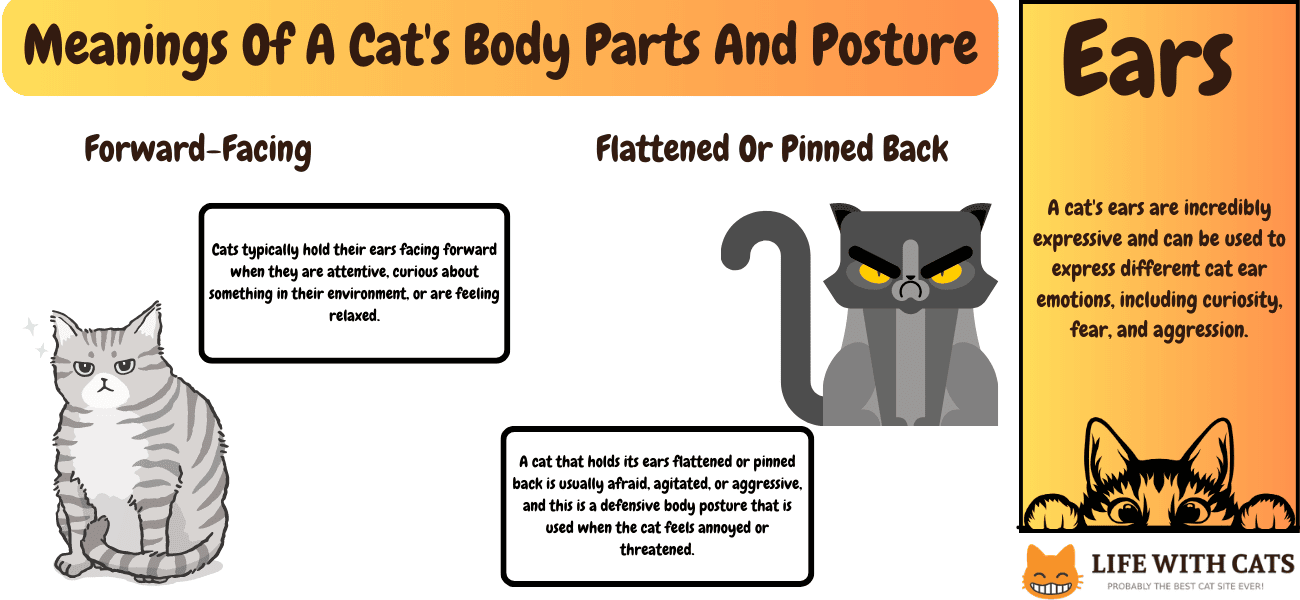
A cat’s ears are incredibly expressive and can be used to express different cat ear emotions, including curiosity, fear, and aggression.
Forward-Facing
Cats typically hold their ears facing forward when they are attentive, curious about something in their environment, or are feeling relaxed.
Flattened Or Pinned Back
A cat that holds its ears flattened or pinned back is usually afraid, agitated, or aggressive, and this is a defensive body posture that is used when the cat feels annoyed or threatened.
Whiskers
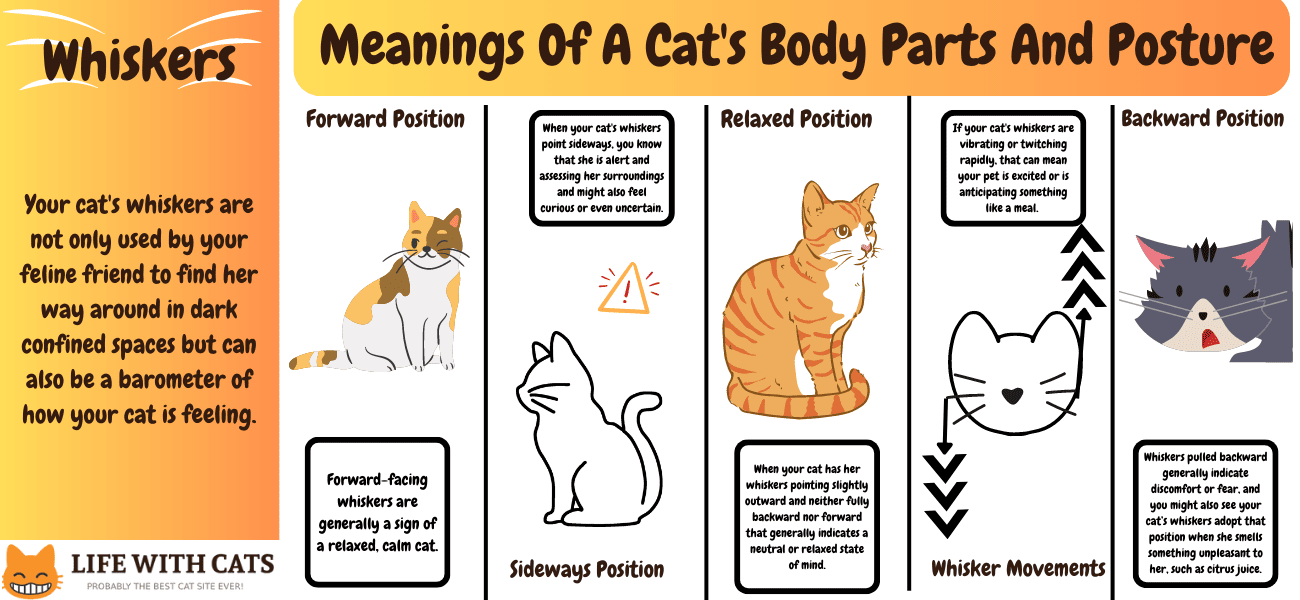
Your cat’s whiskers are not only used by your feline friend to find her way around in dark confined spaces but can also be a barometer of how your cat is feeling.
Forward Position
Forward-facing whiskers are generally a sign of a relaxed, calm cat.
Relaxed Position
When your cat has her whiskers pointing slightly outward and neither fully backward nor forward that generally indicates a neutral or relaxed state of mind.
Backward Position
Whiskers pulled backward generally indicate discomfort or fear, and you might also see your cat’s whiskers adopt that position when she smells something unpleasant to her, such as citrus juice.
Sideways Position
When your cat’s whiskers point sideways, you know that she is alert and assessing her surroundings and might also feel curious or even uncertain.
Whisker Movements
If your cat’s whiskers are vibrating or twitching rapidly, that can mean your pet is excited or is anticipating something like a meal.
Eyes
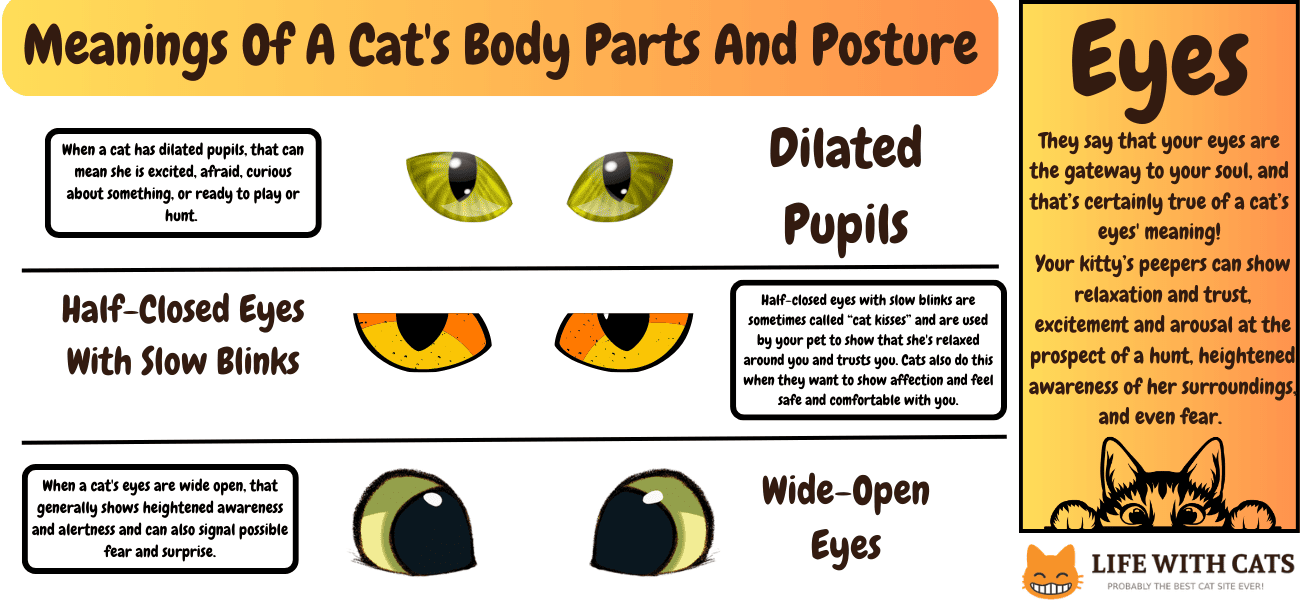
They say that your eyes are the gateway to your soul, and that’s certainly true of a cat’s eyes’ meaning!
Your kitty’s peepers can show relaxation and trust, excitement and arousal at the prospect of a hunt, heightened awareness of her surroundings, and even fear.
Here’s a guide to your cat’s eyes and what they mean.
Dilated Pupils
When a cat has dilated pupils, that can mean she is excited, afraid, curious about something, or ready to play or hunt.
Half-Closed Eyes With Slow Blinks
Half-closed eyes with slow blinks are sometimes called “cat kisses” and are used by your pet to show that she’s relaxed around you and trusts you. Cats also do this when they want to show affection and feel safe and comfortable with you.
Wide-Open Eyes
When a cat’s eyes are wide open, that generally shows heightened awareness and alertness and can also signal possible fear and surprise.
Body Posture
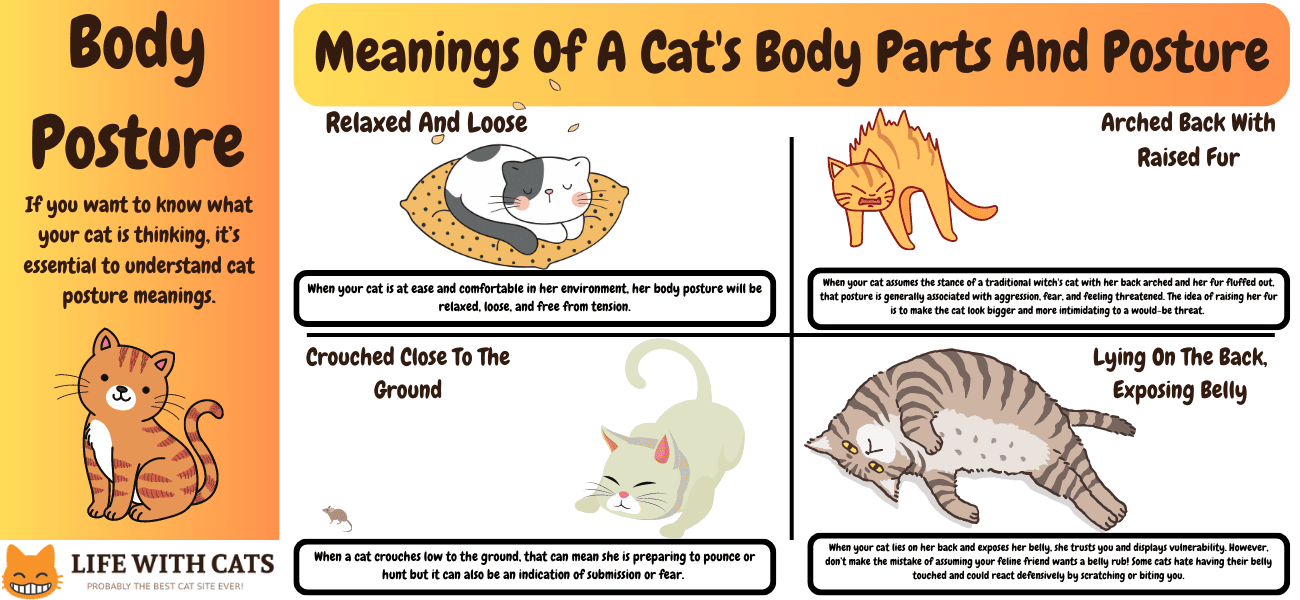
If you want to know what your cat is thinking, it’s essential to understand cat posture meanings.
A chilled cat will have a relaxed, loose body posture, whereas one that feels feisty and aggressive could have an arched back and raised fur. A crouching cat could be preparing to pounce or cower away from something she’s afraid of, and a cat that’s lying belly-up on her back is likely showing you that she’s trusting and vulnerable.
Relaxed And Loose
When your cat is at ease and comfortable in her environment, her body posture will be relaxed, loose, and free from tension.
Arched Back With Raised Fur
When your cat assumes the stance of a traditional witch’s cat with her back arched and her fur fluffed out, that posture is generally associated with aggression, fear, and feeling threatened. The idea of raising her fur is to make the cat look bigger and more intimidating to a would-be threat.
Crouched Close To The Ground
When a cat crouches low to the ground, that can mean she is preparing to pounce or hunt but it can also be an indication of submission or fear.
Lying On The Back, Exposing Belly
When your cat lies on her back and exposes her belly, she trusts you and displays vulnerability. However, don’t make the mistake of assuming your feline friend wants a belly rub! Some cats hate having their belly touched and could react defensively by scratching or biting you.
Paw Positions
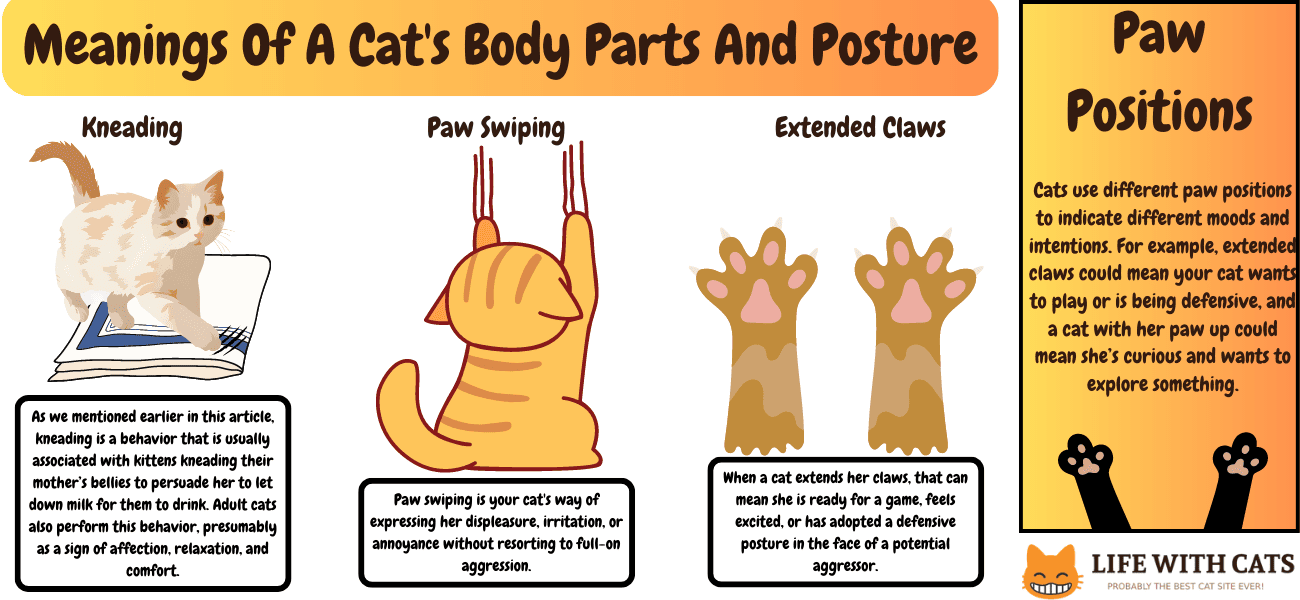
Cats use different paw positions to indicate different moods and intentions. For example, extended claws could mean your cat wants to play or is being defensive, and a cat with her paw up could mean she’s curious and wants to explore something.
One cat paw reference that we’re all familiar with is kneading. Kneading is usually associated with feelings of comfort and relaxation and originates as kitten behavior that most cats continue to exhibit in adulthood.
Kneading
As we mentioned earlier in this article, kneading is a behavior that is usually associated with kittens kneading their mother’s bellies to persuade her to let down milk for them to drink. Adult cats also perform this behavior, presumably as a sign of affection, relaxation, and comfort.
Extended Claws
When a cat extends her claws, that can mean she is ready for a game, feels excited, or has adopted a defensive posture in the face of a potential aggressor.
Paw Swiping
Paw swiping is your cat’s way of expressing her displeasure, irritation, or annoyance without resorting to full-on aggression.
Cat Sleeping Position
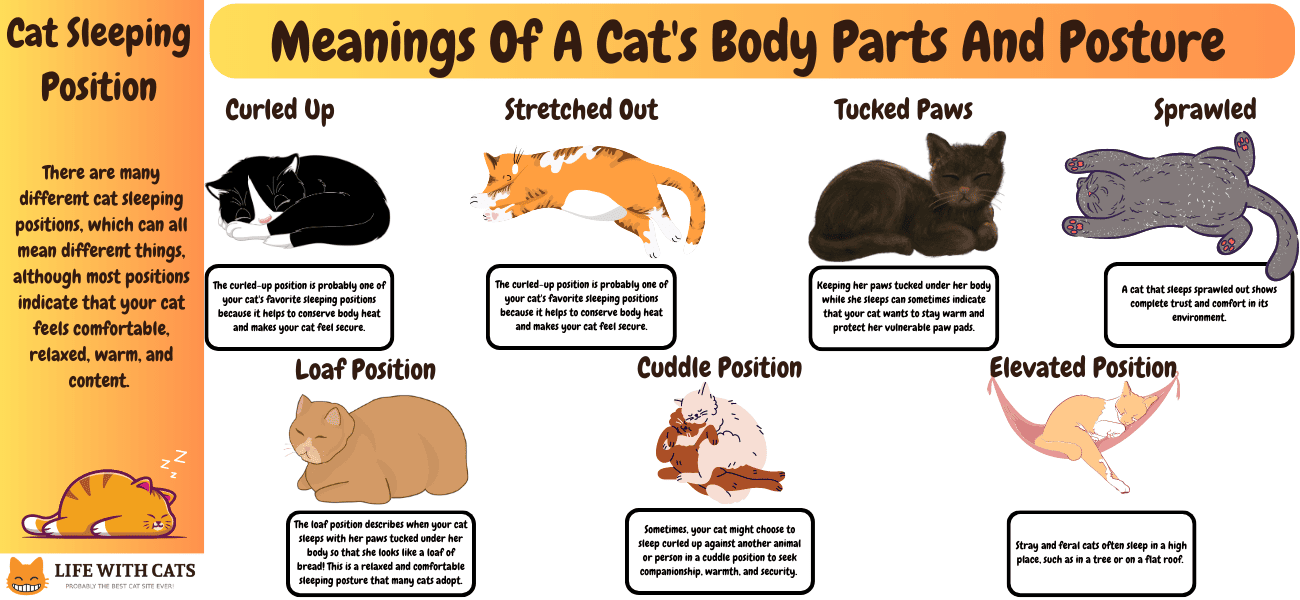
There are many different cat sleeping positions, which can all mean different things, although most positions indicate that your cat feels comfortable, relaxed, warm, and content.
Here’s a guide to help you interpret your cat’s sleeping position meaning.
Curled Up
The curled-up position is probably one of your cat’s favorite sleeping positions because it helps to conserve body heat and makes your cat feel secure.
Stretched Out
When your cat sleeps stretched out, that generally means that she feels relaxed and safe in her surroundings.
Tucked Paws
Keeping her paws tucked under her body while she sleeps can sometimes indicate that your cat wants to stay warm and protect her vulnerable paw pads.
Sprawled
A cat that sleeps sprawled out shows complete trust and comfort in its environment.
Loaf Position
The loaf position describes when your cat sleeps with her paws tucked under her body so that she looks like a loaf of bread! This is a relaxed and comfortable sleeping posture that many cats adopt.
Cuddle Position
Sometimes, your cat might choose to sleep curled up against another animal or person in a cuddle position to seek companionship, warmth, and security.
Interestingly, my cats started sleeping cuddled up together soon after I bought my puppy, and I think they do that to feel safe and secure when he is charging around the house!
Elevated Position
Stray and feral cats often sleep in a high place, such as in a tree or on a flat roof.
That’s generally a way for the cat to feel safe and secure and provides her with an excellent vantage point where she can watch out for potential danger while resting in safety.
What Are The Various Signs Of Emotions And Feelings Displayed By Cats?
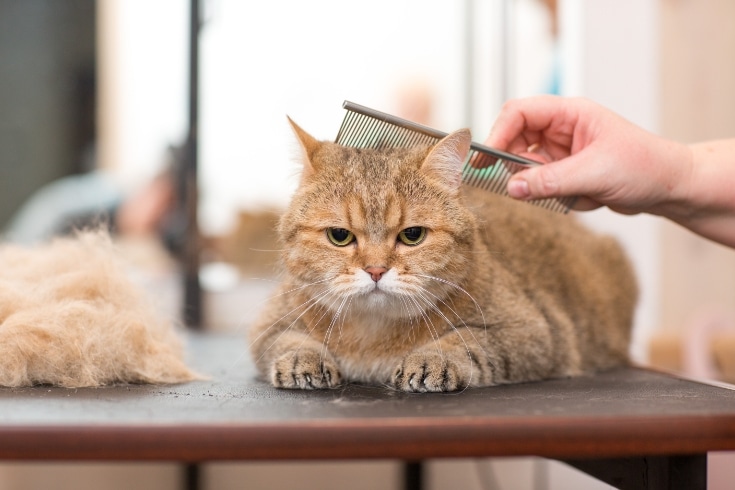
The different cat signs of emotions and feelings are critical to your developing a strong bond with you, and they can be extremely important when training a cat to display a particular behavior or perform a trick.
For example, if you can “read” your cat to know when she’s in the mood to learn or when she simply wants to play, that can make training much easier.
Here’s an overview of the various signs of emotions and feelings your cat displays daily to give you a deeper understanding of your precious pet.
Contentment And Relaxation
A relaxed cat typically has a relaxed, loose body posture and appears to be at ease, possibly lying down on her back or side with her legs stretched out or tucked under her body.
A relaxed cat often exposes her belly by rolling over her back. But be warned! Although that looks cute, and you might be tempted to give your pet a belly rub, proceed with caution. Not all cats appreciate that kind of attention, and you risk getting scratched!
When a cat is content, she will often partially close her eyes in what looks like a slow blink, showing that she is relaxed and trusts you.
Purring is a soothing sound that cats make when they feel safe, secure, and relaxed, so if your cat starts to purr when you approach her, you will know that she is content. Purring is often accompanied by a kneading motion with the cat’s paws and is a behavior that’s usually associated with kittenhood when a kitten kneads her mother’s belly to stimulate milk flow.
Relaxed cat ears will be held in a neutral position rather than flattened against the cat’s head or pinned back. A relaxed cat might wrap her tail loosely around her body or leave it lying still without signs of puffing up or twitching.
A relaxed cat moves gracefully and slowly without any signs of tension or sudden movements. One of my cats makes super cute trilling sounds when she is happy and content; vocalizations of that nature are something else to look out for in a relaxed cat.
Fear Or Anxiety
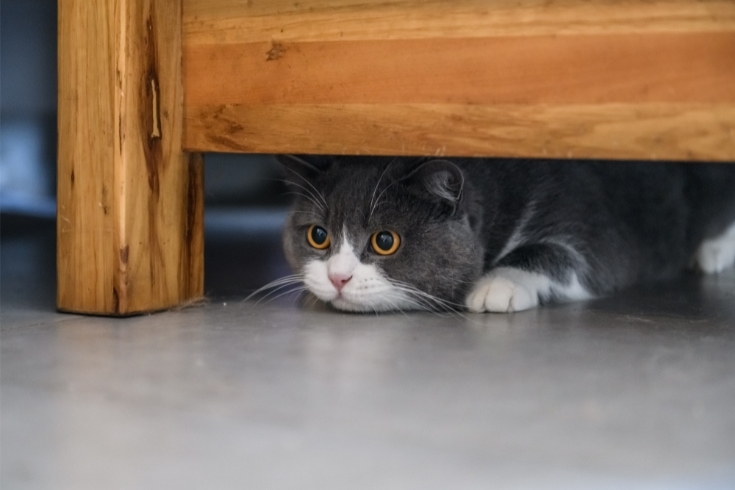
If your cat is afraid and anxious about something, she might seek a hiding place to retreat to and feel safe, such as on a cupboard or inside a cardboard box.
Some cats groom themselves excessively as a kind of feline coping mechanism when they feel anxious or stressed. Unfortunately, that kind of over-grooming can often lead to skin irritation, hair loss, and even secondary bacterial skin infections.
When cats are anxious or afraid, their pupils often become dilated so that they can take in more visual information and be more alert to potential dangers and threats. A fearful cat might tuck her tail between her legs or wrap it tightly around her body in a sort of defensive posture.
A cat that feels threatened often uses vocalizations, such as growling or hissing, to warn away potential aggressors. One of my cats does that every time my puppy gets too close to her, although I know she would not scratch him.
If a cat feels threatened, she will probably avoid making direct eye contact with you because other cats perceive prolonged staring as a threat or challenge. So, when dealing with a frightened stray, for example, recognize those signs of fear and try not to look her directly in the eyes.
In situations when a cat is highly stressed and afraid, she might tremble or start shaking, although you don’t generally come across that fearful cat body language very often. Cat kneading anxiety is another uncommon anxious cat behavior that should not be confused with relaxation and contentment.
Fearful Or Stressed Cat Body Language
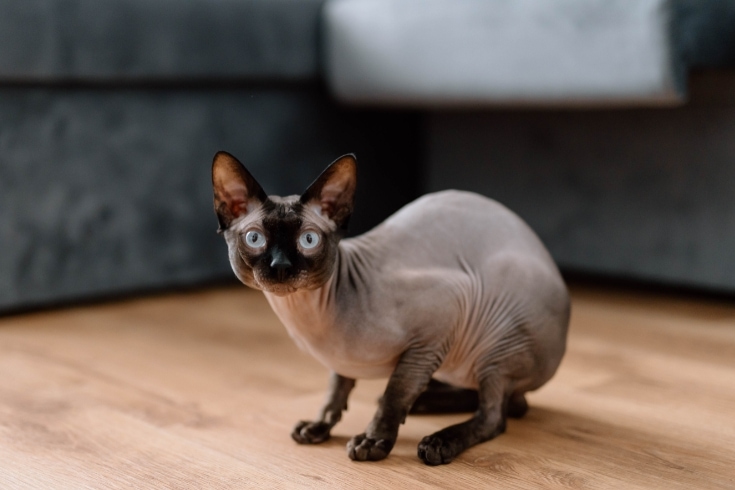
When your cat is fearful or stressed, she might puff up her fur to make her self-look larger, more intimidating, and less vulnerable. A fearful cat might also crouch low to the ground with her body tense, which shows she is prepared and ready to run away if necessary.
If a cat is frightened of something or someone, she might tuck her tail tightly between her back legs to protect her vulnerable rear end, her pupils will be dilated and large, and her ears could be flattened against her head as a defensive posture.
Your cat might avoid making direct eye contact with you, as that could be seen as a threat or challenge, and some frightened cats hiss or growl as a warning.
Handling and Responding To Fearful Cats
Handling and responding to fearful cats demands patience, understanding, and a quiet approach, and you should be aware that a frightened cat might scratch or bite as a means of defense.
First of all, you must provide somewhere quiet and secure for the cat to retreat to and offer hiding places, such as an igloo cat bed or even an old cardboard box, where the cat can feel safe.
Crucially, you must let the cat come to you on her terms rather than approaching the cat when she’s frightened. Use a calm, soothing voice when speaking to the cat so that she knows you’re not a threat, and avoid making any sudden movements or loud noises that might startle her.
When the cat shows signs of curiosity and becomes calmer, offer treats and rewards to help build her trust and encourage that positive behavior. Sometimes, using a synthetic pheromone spray or plug-in product, such as Feliway, works well to calm a frightened cat.
Aggression
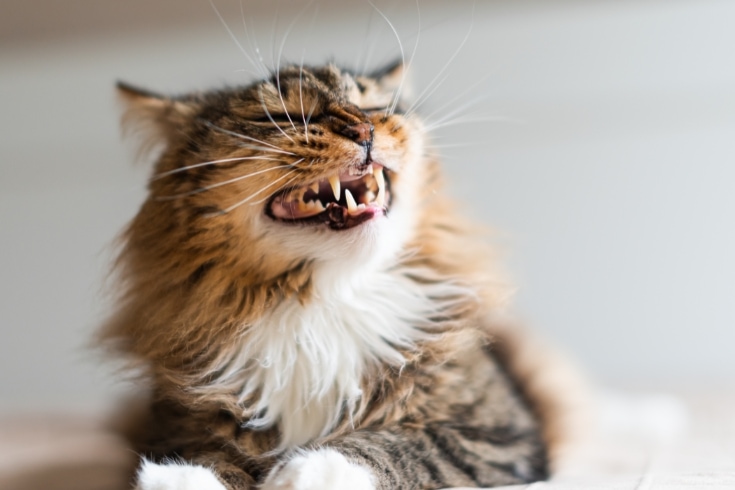
Aggression in cats has various underlying causes, including fear, pain, sickness, territoriality, and even past traumatic experiences.
Common signs of aggression in cats are vocal ones that most cat owners have seen at some point or other in their lives. Your cat might hiss or growl to show her discomfort or fear, often while swatting with a paw, nipping, or scratching you or another animal as a form of defense.
When it comes to body language, your cat might have her ears pinned back flat against her head while arching her back and fluffing up her fur (piloerection) to try to appear larger and more intimidating if she feels threatened by another animal. A twitching or swishing tail is another sign of feline irritation and aggression.
Aggressive Cat Body Language
Knowing how to recognize aggressive cat body language cues can help you to avoid conflict and potential injury.
An aggressive cat might flatten its ears against its head or twitch them back and forth, and its eyes will have dilated pupils and be focused on potential threats in a direct, alert gaze. The cat might hold its tail low or tucked close to its body or thrash it rapidly back and forth to show irritation and agitation. Aggressive cats often hiss, spit, or growl, and sometimes their fur stands on end to make the animal appear larger and more intimidating.
An aggressive cat might arch its back like a witch’s cat image or tense its body and crouch low to the ground. Take great care when approaching a cat displaying these signs, as you could be swatted at or even bitten if you get too close.
Handling and Responding to Aggressive Cats
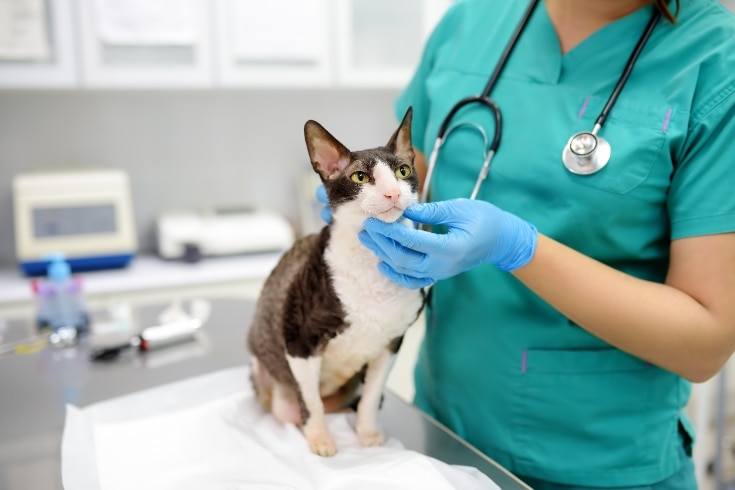
Your first action should be to work out what’s causing your cat’s aggression and take steps to solve that problem. I also recommend asking a vet to look at your cat to determine if your pet is in pain, making her aggressive.
When approaching an aggressive cat, be sure to give her plenty of space, as crowding a cat in that state could result in her attacking you. If possible, provide the cat with a safe space, a comfortable bed, and hiding places, such as old cardboard boxes.
Stay calm, speak quietly to the cat, and avoid making direct eye contact with her so that she doesn’t view you as a threat. Use positive reinforcement, such as rewarding your cat with treats and praise when she’s calm so that she learns to associate that behavior with a nice experience.
Affection and Trust
The signs of a cat’s affection can be very subtle, so you’ll need to know how to spot them if you’re to know how strong the bond is between you and your pet.
One of the most recognizable signs of cat affection is purring, which cats often do when they are relaxed and content, and this is usually a clear sign that your feline friend feels safe and comfortable around you.
As mentioned earlier, cats often knead with their paws, pushing them in and out against a soft surface, such as your lap or a snuggly blanket, as a sign of trust and love. When your cat rubs her head, face, or body against you or items of furniture in your home, she is marking her territory with her scent as a way of claiming you as part of her space and showing affection, and can be clear signs a feral cat trusts you.
If your cat makes eye contact with you and then slowly blinks, that is considered a sign of affection and trust and is known as a “ cat kiss.” When a cat rolls on her back and shows you her belly, that’s a sign of vulnerability, and if she allows you to pet her or lies on her back close to you, that’s a sign your cat trusts you completely.
Although it might not seem like a particularly affectionate gesture, when your cat presents you with her rear end, that is actually a sign of acceptance and absolute trust since she is displaying a very vulnerable area.
Playfulness
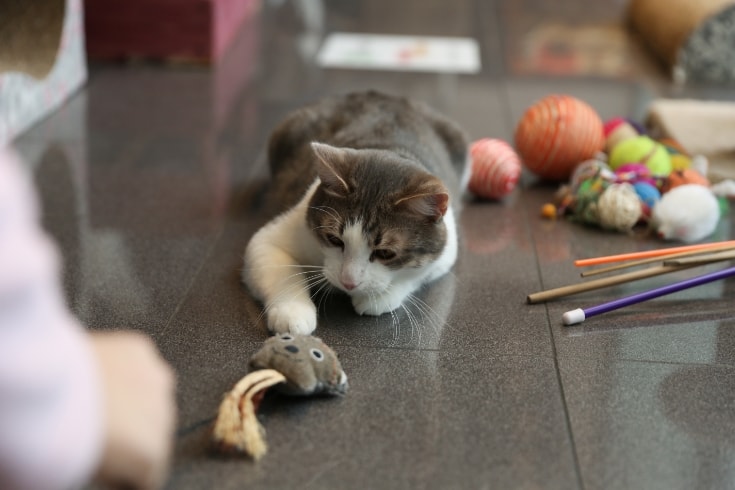
Are cats playful? Well, that all depends on the individual cat! Some cats are incredibly playful and remain from kittenhood into their senior years, while others can take or leave the offer of a game.
So, how to tell if a cat is playing or angry?
A twitching tail can indicate that your cat is excited and feeling playful, especially when she crouches down low to the ground, wiggles her rear end as if stalking prey, and then leaps out to grab a toy or housemate.
Playful cats typically have a relaxed body posture with their whiskers relaxed and their ears pointing forward, and their pupils are often dilated.
Finally, a playful cat often makes cheeky chirping or trilling sounds to accompany her cat’s playful body language.
Playful Cat Body Signals
There are many playful cat body signals to watch out for, telling you that your pet is in the mood for a game.
- Your cat’s tail might twitch or flick when she’s in a playful mood to indicate excitement.
- Your cat could crouch down with her rear end raised, telling you she’s ready to pounce on a toy or your hand!
- Some cats might chase their tails in a playful manner or dart back and forth for no apparent reason.
- If your cat rolls over, exposing her belly, that usually indicates that she’s in a playful mood.
- Your cat might playfully swat at her toys during play to replicate how she would interact with prey.
Differentiating Play From Aggression In Cats
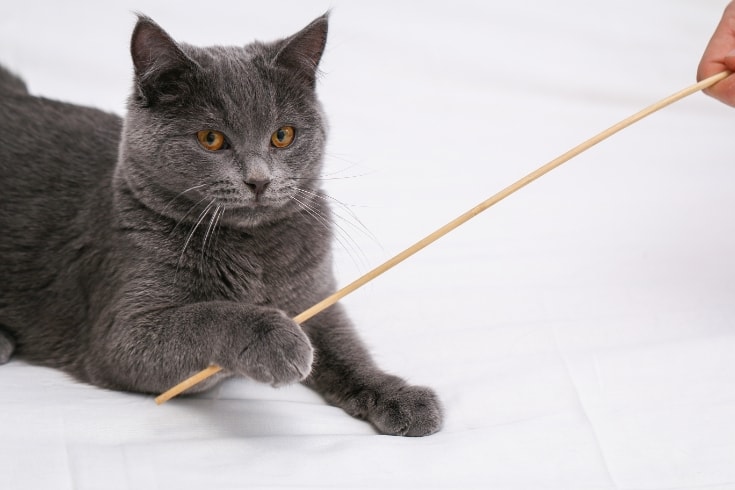
Although many of the physical behaviors your cat shows during play are similar to those of aggression, your cat won’t be as tense in her body, she won’t have her ears pinned back against her head, and she shouldn’t hiss or spit at you.
In addition, cats at play don’t generally have their fur fluffed up or adopt the witch’s cat position.
Safely Engaging In Play Based On Cat Body Language
When playing with your cat or kitten, you should not use your hands or feet as toys! That can encourage rough play and can lead to unintentional biting or scratching, always use a toy as an intermediary.
When using interactive toys, avoid fast and erratic movements that can frighten or overstimulate your cat, and keep your movements slow and gentle to keep the cat’s interest. If your cat starts to get over-excited during a place session, take a break and let your cat calm down before resuming the game.
During playtime, pay close attention to your cat’s body language, and look for signs of enjoyment, such as purring and a relaxed body posture. If your cat starts swishing her tail, flattens her ears, or hisses at you, those are signs of stress and aggression, so stop the play immediately and give your cat space.
Stress, Illness, Or Discomfort
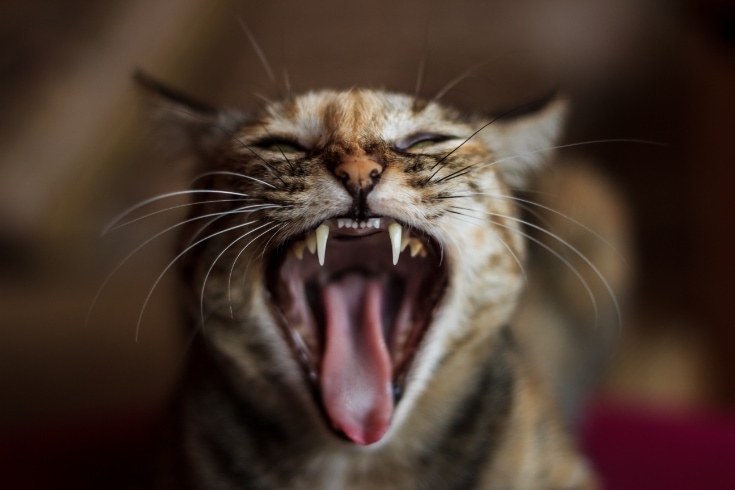
It’s essential for cat owners to know how to recognize the behavioral signs of a cat in pain and of a distressed cat.
A distressed cat might over-groom herself as a kind of coping mechanism, leading to bald patches, hair loss, skin irritation, and secondary skin infections. Cats that are in discomfort or feeling stressed often vocalize more than usual, including excessively howling or meowing.
I once had a senior cat that would wander around the house at night howling incredibly loudly. I took her to the vet, who concluded that my cat had early-onset feline dementia, so I would advise you to get your cat checked over if she displays any signs of stress or discomfort.
You might also notice your cat’s pupils are dilated when she’s stressed, although that can also be a sign of playfulness, so you’ll need to learn how to read stressed cat body language accurately so that you can help your pet.
Changes in Body Language as Indicators of Illness
Cats are masters of disguising illness, but there are a few indicators in their body language that can give them away.
If a cat is sick, she will often become withdrawn and might hide away, although that does depend on the individual cat’s personality. Other felines can become more attention-seeking, whereas others become bad-tempered. However, most cats have lower energy levels and are less likely to want to play when they are sick.
Recognizing Pain or Discomfort through Cat Body Language
Obvious signs of pain or discomfort in cats include limping, avoiding being handled or petted, and stopping grooming.
Other subtle signs include your cat closing her eyes or squinting, holding her ears flat or pressed to her head, and having a tense mouth, nose, and cheeks.
When to Consult a Vet Based on Cat Body Language
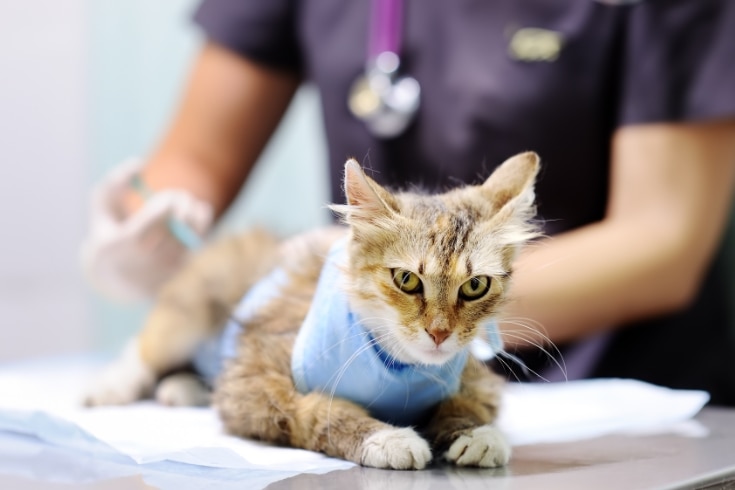
If your cat’s body language changes noticeably for no apparent reason, she could be sick or in discomfort, and you should ask your vet for advice. Remember that the signs of trouble can be very subtle, so don’t ignore anything suspicious; your cat could be in pain and hiding it.
Curiosity And Alertness
A curious, alert cat displays various body language clues that tell you your cat is engaged and attentive to her environment.
A cat that’s curious about her surroundings typically has her ears pointed forward or slightly to the sides, indicating that she is listening to sounds and trying to work out what they are and where they are coming from.
An alert cat typically has her eyes wide open and focused on whatever she is looking at, and sometimes, an excited cat will also have dilated pupils. Your cat uses her whiskers to detect changes in air currents and gauge her surrounding environment, so a curious cat typically has her whiskers slightly fanned out and pointing forward.
A twitching tail often indicates anticipation or excitement, and a tail that’s carried upright with a slight curve at the end shows interest and attentiveness. If your cat is curious or attentive to a new environment, she might extend a paw to explore her surroundings further.
Curious cats often vocalize, using meows, soft trills, and chirps to get your attention or express their interest in something. One of my cats loves to sit on the windowsill watching the birds outside in the trees, quietly trilling as she does so.
What Are The Tips For Understanding And Effectively Communicating With Your Cat?
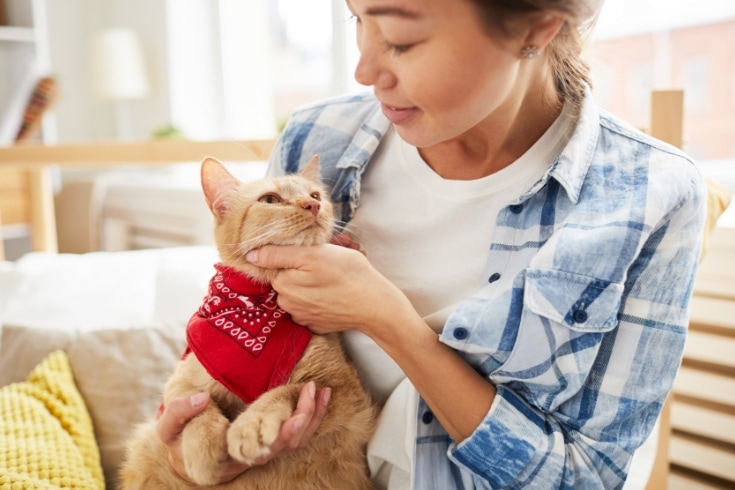
Here are some tips for understanding and effectively communicating with your cat, especially through their body language.
Creating A Safe Environment
Your cat will feel most comfortable and relaxed in a secure, safe space, so provide her with a quiet and warm space to relax and sleep. Make sure your house is cat-safe by checking for potential hazards, and always ensure your cat has access to food, water, and a clean litter box.
Building Trust
Trust forms the foundation of any lasting relationship, including with your cat.
Don’t force your cat to interact with you but allow her to approach you on her terms, and when training your cat, always use positive reinforcement methods with plenty of rewards and praise.
If you adopt a stray cat or one from a rescue center, spend plenty of time sitting near them, talking softly to them, and offering lots of treats. Eventually, your new furry friend will learn to trust you and come to you willingly for love and affection.
Active Observation
As you’ve learned in this article, cats communicate through their expressions, ear positions, tail movements, and vocalizations, and it’s up to you to learn how to interpret and understand your cat’s body language.
Once you understand what your cat is trying to say to you, you will be better able to provide her with what she needs and wants.
Respect Boundaries
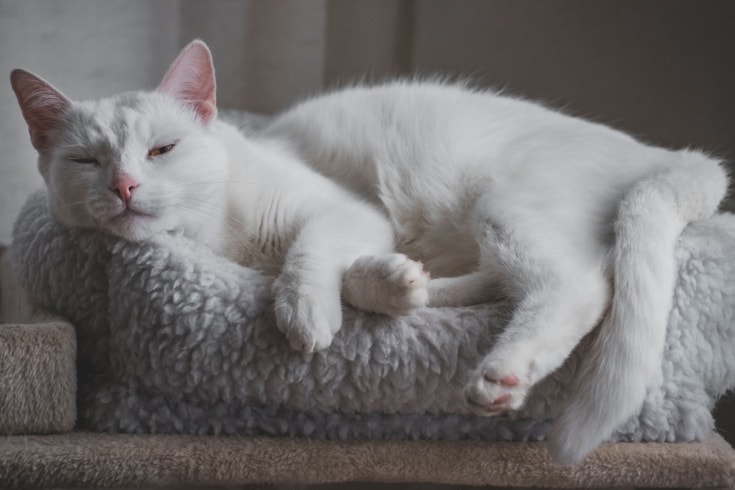
Cats are very independent creatures, and they value their personal space, so if your cat isn’t in the mood for a training session, a cuddle, or playtime, respect their boundaries, and let your pets come to you when she is ready.
Positive Reinforcement
Use positive reinforcement in all your interactions with your cat, including during training sessions. Positive reinforcement means rewarding your pet with treats, praise, and a gentle fuss when she displays desirable behavior and responds correctly to your verbal cues. That positive association encourages your feline friend to repeat that good behavior in the future.
Conclusion
Your cat’s body language is basically her way of communicating with you and telling you how she’s feeling and what her intentions are. Your feline friend uses various postures, behaviors, vocalizations, and movements to do that. Your cat uses her body and its position to show you when she feels happy and relaxed, aggressive, afraid and anxious, or in discomfort.
Your cat’s body parts and their position include her tail and ears, eyes, whiskers, body posture, how she holds her paws, and sleeping position. Vocalizations also form part of your cat’s language, including purring, growling, howling, and meowing, all of which she uses to tell you how she’s feeling or what she’s doing.
Understanding and interpreting your cat’s body language is crucial in building a bond between you, and we hope this guide has set you on the right path to doing exactly that!